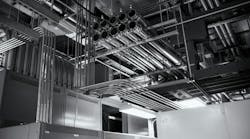Rebuilding the World Trade Center
A project executive looked out his window on the morning of September 11, 2001. Not a cloud was in the sky, and he had a clear line of site from his office to lower Manhattan. In the moments that followed he witnessed an event he will not soon forget — the collapse of the Twin Towers.
Leonard Impastato, a 40-year electrical industry veteran who works for Five Star Electric, is now working with John McManus, the general foreman, to supervise a team of 45 electricians on the landmark $700 million initial rebuild of the World Trade Center. Five Star, E-J Electric Installation Co., and Zwicker Electric are providing electrical, lighting, and control services for the construction of No. 7 World Trade (7 WTC). The destruction of the Twin Towers structurally weakened 7 WTC, which was built on top of a substation building that supplied electricity to downtown Manhattan. The construction crew leveled the existing building and cleared the land for the new 7 WTC. Five Star and E-J Electric are preparing the space for the Con Ed utility substation, which will include five 138kV transformers. Once that phase is complete, Zwicker will provide electrical services for the core of the 50-story, parallelogram-shaped high-rise, which will be built on the footprint of the former 7 WTC and the surrounding area.
Dwight Millman, a project manager for E-J Electric, says his team faced many challenges in the initial phases of the project. Because the team was working on the site of the wreckage of an existing building, it was difficult to safely access the jobsite. The construction workers also encountered underground obstructions, remnants of the former building, and massive amounts of groundwater. To make the building structurally sound and protect it against future possible attacks, the engineers specified that many of the walls be 2 feet thick in the lower levels of the building. The first five floors were constructed of poured concrete, and a steel-based structure will be built on top of this foundation to form the shell of the building.
“There are massive amounts of concrete from the cellar to the fourth floor,” Impastato says. “It looks like a fortress.”
On a traditional high-rise construction project, a team builds one floor at a time, but on the 7 WTC project, the electricians are working on four or five different floors simultaneously. Five Star is installing thousands of feet of cable tray, conduit, and power and control cable, putting in lighting fixtures, and placing conduit into the poured concrete. E-J Electric, the Long Island City, N.Y.-based firm that installed the security system for the original WTC, is providing a temporary service of 4,000A for the initial and future phases of construction, installing nine miles of conduit for medium-voltage and high-voltage distribution duct banks and putting in 8-foot by 8-foot horizontal ground plates and ground rods for lightning protection.
In late December, New York's governor and mayor led a “topping off” ceremony to celebrate the end of the first phase of the project — the completion of the five-story concrete base of the building. But the construction project is far from over. In the early part of this year, Con Ed will power up its substation equipment to supply electricity to the future World Trade Center projects, including the construction of the proposed 1,776-foot tall Freedom Tower, which will feature 60 floors of office space. In the meantime, the electrical firms added manpower and ramped up on overtime to meet their obligation to Tishman Construction, which promised to turn over 85% of the space to Con Ed by the first week in January. Five Star's electricians worked 10-hour days during the week and 8 hours on Saturdays to get the job done on time. Despite the heavy workload, Impastato says the construction team has pulled together to complete the 7 WTC project.
“There's a real spirit of cooperation that you normally wouldn't see on a construction project,” he says. “You can almost feel it when you walk through the area. It's heartening to see the area coming back and becoming more and more vibrant. Every week I go down there I see an increased level of activity.”
Photo courtesy of advanced media design, inc.





